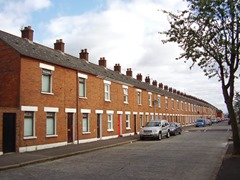Housing: a mixed recovery
 As house sales recover, agendaNi scrutinises the different trends for the volume and prices of transactions.
As house sales recover, agendaNi scrutinises the different trends for the volume and prices of transactions.
Northern Ireland’s housing recovery, in terms of properties sold, is well under way with more than 4,000 transactions taking place per quarter. The trend has been apparent since last autumn in the Northern Ireland Residential Property Price Index, which examines every sale notified to HMRC.
Finance Minister Simon Hamilton has interpreted the findings as “further evidence of steady, balanced growth”. Sales had risen by 21 per cent between Q1 2013 and Q1 2014.
A different picture, though, emerges in property prices which rose by just 7 per cent in the same timeframe. Pre-crisis property prices in Northern Ireland may only return in 2024 or even later, according to PwC’s current UK Economic Outlook. Prices peaked in August 2007 when they were eight times higher than an average household’s earnings and exceeded those in London. By Q4 2013, PwC estimated that Northern Ireland’s prices represented 3.5 times an average earning with only a modest recovery under way.
The province was therefore 50 per cent below peak levels whereas Scotland and Wales are 4.7 per cent and 3.5 per cent below peak (respectively). Those regions experienced a much slower growth in prices before the recession; the almost exponential growth in Northern Ireland was influenced by the Republic’s housing boom.
London’s prices were 32 per cent above the pre-recession peak and had reached the same prices-to-earnings ratio that Northern Ireland experienced back in 2007.
The property market has a clear bearing on Northern Ireland’s economic growth. PwC estimates that regional growth was 1.1 per cent in 2013 and will rise to 2.2 per cent in 2014. This compares with 1.7 per cent and 3 per cent nationally in those respective years.
“Interest rates are expected to rise during 2015,” PwC Chief Economist Esmond Birnie commented. “And this, combined with our proportionally low disposable income and high percentage of negative equity, will represent a substantial call on future workforce earnings.
“Collectively all these factors have contributed to relatively low levels of demand and only as the legacy of the property bubble and the accompanying debt overhang are worked out of the system will we see increasing domestic demand and accelerated recovery.”
PwC expects the Bank of England to keep interest rates (currently 0.5 per cent) on hold in the short term but then to increase them gradually from late 2014 or early 2015 onwards – perhaps rising to around 4 per cent by 2020.
Regarding the economics of housing, Simon Hamilton has commented: “The current more balanced relationship [between prices and earnings] is to be welcomed and is particularly good news for first time purchasers and those wishing to move up in a more affordable and stable housing market.”
The Ulster Bank’s May 2014 Purchasing Managers Index indicates that construction output, employment and new orders have been expanding since the summer of 2013. The same trends of expansion are evident across housing, commercial and civil engineering projects.
On a separate note, Nama still owns £40 million of assets in the province across nine properties. Most are commercial or industrial nature, although the listing includes a property development in South Belfast valued at £2.5 million.
Prices (Q1 2014)
| Category | £ |
| Detached | 157,386 |
| Semi-detached | 101,238 |
| Apartment | 80,029 |
| Terraced | 68,727 |
| All residences | 102,034 |
Sales
| Quarter | No. |
| Q1 2013 | 3,474 |
| Q2 2013 | 3,909 |
| Q3 2013 | 4,242 |
| Q4 2013 | 5,076 |
| Q1 2014 | 4,189 |





